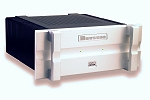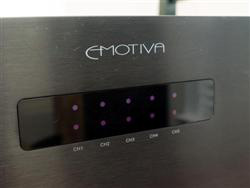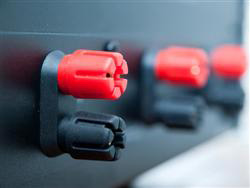Introduction
Over the past decade, lots has changed on receivers that we buy for home. We’ve gone from S-Video to Component to HDMI for video, replaced 6 RCA cables for 5.1 audio with a single digital cable, to having it integrated in the HDMI signal along with video. Receivers have added all sorts of new functions with better on screen menus, room correction, Ethernet ports for streaming media and firmware upgrades, and we have also moved from 5.1 channel audio, to 6.1, then 7.1, and now all the way to 9.1 or greater when using Dolby ProLogic IIz or Audyssey DSX. However, one thing on receivers has barely changed when I look back over the spec sheets: weight.
Receivers are now designed to drive almost twice as many channels of audio as before with their internal amps, but the amplifiers have typically stayed the same in weight, or even gone down, which leads me to believe that those amplifier sections are underpowered. Typical Class AB amplifiers that are found in receivers need large transformers to have power reserves to be able to drive speakers during dynamic passages in music or movies, and those alone can weigh more than a whole receiver does. For the majority of mass market receivers, they just don’t have the power reserves when more than 1 or 2 channels need lots of power. My own Onkyo TX-SR706B is rated for 100 watts per channel, and in testing people have found that while it can do 122 watts per channel with 2 channels drives, when you drive 5 channels at once, the power output drops down to 75 watts. Imagine what adding 4 more channels would do to it’s maximum power output?
Thankfully, many receivers have pre-out jacks that let you add an external amplifier to your receiver. If your receiver has a 9 channel pre-amp output, you can add an amp for as many channels as you want, and since the internal amp is working less, it can power the remaining channels better than it could before. When I saw that Emotiva had announced a new 5 channel amp in their Ultra line, the UPA-5, I quickly asked if they could send one over so I could hook that up to my Onkyo and see what benefit an external amp might provide me.
Specifications
- Design: Five-channel Power Amplifier
- Power Output: 125 Watts RMS x 5 into 8 Ohms; 185 Watts x 5 into 4 Ohms
- THD+N: 0.1%
- Connectors: RCA Unbalanced and XLR Balanced; Five-way Speaker Binding Posts
- Dimensions: 7.8″ H x 17″ W x 19″ D
- Weight: 58 Pounds
- MSRP: $549 USA
- Emotiva
Design
The UPA-5 is not a tiny amplifier. In fact, it’s so large that it wouldn’t fit in my current AV rack and finally led me to upgrade to a different one that would be able to easily hold it and all of my other gear. It’s also much heavier than your receiver most likely is, weighing 58 pounds out of the box, and continuing FedEx’s love-hate relationship with me. All of Emotiva’s amplifiers come in the same size case, which helps them to keep their prices lower, as it’s much simpler to manufacturer a single case for the whole product line. That also means that the UPA-5 will run cooler than some other amplifiers as it’s case is designed to hold even more powerful amps, though you should still provide it plenty of ventilation.
The front of the UPA-5 has a single power button, and two rows of LED’s to indicate power to the 5 channels. The rear panel has the main power switch, five RCA inputs, 5 sets of binding posts that will accept bare wire, banana plugs, or spades, and a set of 12V triggers. As this case can also be used for a 7 channel amp, there is plenty of space between the binding posts to allow for even the most inflexible speaker wire. The binding posts are nice and sturdy, though not as fancy as you might see on their X series amplifiers, but I had no issues tightening them onto spade lugs, or using banana plugs. Perhaps they could be spaced a bit further apart if you were running a pair of shotgun biwire cables with spades, but I was able to make even that setup work.
Overall, the Emotiva feels incredibly well built, very sturdy, and is a very heavy piece of equipment. The UPA-5 has a large 600VA transformer in addition to 90,000µF of secondary capacitance so it will always have the power to drive all 5 channels at the rates 125 watts (into 8 ohm, 185 WPC at 4 ohm). Given that this weighed twice as much as my whole receiver, I was starting to wonder just how underpowered the amplifier section in my receiver might be.
The UPA-5’s modular construction makes it easy to replace a channel if it becomes defective.
Setup
Thankfully, an amplifier is as easy a setup as you can get for a new piece of home theater equipment. I simply ran 5 RCA cables from my receiver Pre-outs into the 5 channels of the UPA-5, moved the speakers cables over as well, and then turned on the UPA-5. If you don’t want to leave the UPA-5 on all the time you can use the 12V trigger on the UPA-5 and turn it on from the 12V trigger output on your SSP or receiver. My receiver has a 12V output, but it’s only for Zone2 and not for the main Zone unfortunately. It did allow me to test and verify that the 12V trigger did work as advertised, however, but I just chose to leave it on all the time. The only other option you have with the UPA-5 is a switch on the rear panel to turn the front lights on or off, so setup can really take you 5 minutes. I did re-run Audyssey on my receiver after I was finished, just in case it caused any changes that needed to be accounted for, but I didn’t notice any when I looked at the results after it completed.
In Use
After getting the UPA-5 setup, I really wasn’t in the mood for any critical listening for a few days, so I just put on an album to listen to while I read the news. Belle & Sebastian are a band that I love and their third album, The Boy with The Arab Strap, was the album that got me hooked on them. I was just semi-listening for a while, but started to pay more attention as the album went along, and stopped reading completely once we got to “Dirty Dream Number Two”. This was always a song that had a lot going on, but now instead of just hearing a large arrangement of instruments, I was hearing the individual instruments. The soundstage had grown massively as well, both in width and depth. I hadn’t been looking for the changes that the Emotiva would make, but they were impossible to ignore as it really opened up my speakers and made a huge difference over the stock receiver.

Now that I wanted to really push the Emotiva to see what it could do, I fired up the Blu-ray of Fight Club. I’ve seen Fight Club many times before, and so I skipped right ahead to the scene were our narrator visualizes a mid-air plane crash. Driving the speakers as loud as I wanted to, I was enveloped all around by the DTS-HD MA track, but it still had a stunning amount of detail despite the large amount of low bass energy. Loud, dynamic scenes like these are where you can really notice the power of an amplifier: Since it doesn’t have to strain nearly as hard when doing those lower notes, it has plenty of power left to drive the midrange and tweeter to their potential. Instead of getting slightly muddled midbass and treble, you get clear and distinct sounds to go along with the bass. When you hear other people describe a fog being lifted from the speakers, this is the effect they are talking about.

I don’t really like the Dave Matthews Band. My roommate in college played them continuously and shifted me from finding them OK, to being sick of them (In his defense, he probably never wants to hear Radiohead or Belle & Sebastian again). However, the Blu-ray of Dave Matthews with Tim Reynolds at Radio City Music Hall sounds so fantastic that I find myself listening to it again and again, never growing tired of it. With the UPA-5 this disc sounded far better on my system than it previously did. I would sit and listen to the individual guitar strings being plucked, all distinct instead of jumbled together. I was able to drive the volume up to reference levels without losing any of the dynamics or details as the UPA-5 didn’t strain under the load and let me just experience the concert as if I was in the audience.

Overall, the UPA-5 was simple to add into my system, required no upkeep at all, and brought out a whole new level of detail and depth in movies and music. My speakers suddenly sounded like I had paid far more for them than I had, and no matter how much I turned up the volume I never had to worry about clipping or the amp straining under the load.
Conclusions
Since I started reviewing for Secrets, other Secrets writers had told me nothing but good things about Emotiva products that they had reviewed, and many had bought other Emotiva products as well. I can safely say I understand why they were so fond of the company. Their UPA-5 amplifier made a huge difference in the quality of sound from my receiver, and brought out the best from my speakers and all of my other components. Moving to a separate amp also let me setup the path to upgrade from a receiver to a separate processor in the future, though it also now has me wondering just how much difference moving up to a better amp, such as Emotiva’s XPA-2 for my front speakers, might make.
Chances are if you have a receiver that wasn’t a top of the line model, it might have an amplifier section that is underpowered and holding back the performance of your speakers. Adding an external amp isn’t about playing louder, but playing back more clearly, with all of the detail, and depth, that is recorded in the music or on the soundtrack. Adding the UPA-5 onto your system is a fantastic way to get the most out of the equipment you already have, takes no time to setup, and provided me with fantastic results and a nice system upgrade path for the future. Highly recommended for anyone looking to add a home theater amplifier.










